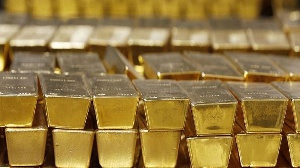Investors are putting pressure on gold miners, whose high greenhouse gas emissions have been less scrutinized, to report transparently and take concrete steps to curb them after a rally in prices this year drew closer attention to the sector's footprint.
Gold miners are among the biggest emitters of greenhouse gases in the mining sector, although critics generally point to coal miners and iron ore miners.
Scope 1 and 2 emissions from gold are higher than those of copper, nickel, iron-ore and metallurgical coal, before factoring in freight and downstream emissions, according to data from ESG consultancy Skarn Associates.
Heavy haul trucks and power supplies are major sources of emissions, while deteriorating gold ore grades have forced miners to dig more rock to extract each ounce of gold in an energy-intensive process.
The World Gold Council estimates the sector emitted 32 689 t of CO2-equivalent per tonne of gold produced in 2018, up 12% from the 2017 total. They have not yet published estimates for 2019.
George Cheveley, portfolio manager at Ninety One, which holds more than a billion dollars in gold assets, said gold miners' emissions data had influenced decisions to shift the weight at which to hold certain companies in his funds.
"These numbers are increasingly important - carbon taxes could come in, so you need to establish your exposure," he said.
In South Africa, the continent's No. 2 producer of gold, a carbon tax on Scope 1 emissions is already in place, and is set to expand to apply to Scope 2 emissions as well from the start of 2023.
Gold miners may have escaped the more intense scrutiny faced by coal or iron ore mining partly because investors use gold as an "insurance asset" and portfolio risk hedge, said Sora Utzinger, responsible investment analyst at Aviva Investors.
"However, we believe this may soon change as more international mining companies chart their own net-zero roadmaps and as governments implement stricter controls on emissions," she said.
Investors sank $47-billion into gold ETFs in the first 10 months of this year, up 203% from last year.
Renewed interest in gold mining stocks - with $3-billion flowing into gold equity funds so far this year - has intensified pressure, executives said.
"We have certainly seen conversations around ESG ramping up pretty significantly," Newmont CEO Tom Palmer said last month.
The miner this month committed to a 30% reduction in greenhouse gas emissions by 2030, and net-zero emissions by 2050.
No. 2 gold miner Barrick has committed to reduce its greenhouse gas emissions by at least 10% by 2030.
For Barrick and others, switching to renewable energy sources to power mines can add to short-term costs. But it helps satisfy investor demands for cleaner operations while significantly reducing longer-term energy costs at mines, which tend to be in isolated, off-grid locations with diesel generators the only option, industry consultants said.
Barrick said a solar power plant at its Loulo mine in Mali delivered a saving of 540 190 ? of fuel and 1 593 t of CO2-equivalent during the third quarter of this year. The miner is busy permitting a 100 MW solar power farm in Nevada.
Being on the grid has downsides.
South Africa's Sibanye-Stillwater and Gold Fields blame their high Scope 2 emissions in part on reliance on the national grid's coal-fired electricity generated by state power firm Eskom.
The South African miners say red tape has stymied their efforts to install renewable energy capacity.
"There will obviously be increasing pressure to reduce emissions from the mines," said a Sibanye-Stillwater spokesman. "But consideration needs to be given to the role and impact of Eskom and limited options available to the gold mines."
Africa Business News of Wednesday, 25 November 2020
Source: miningweekly.com

















